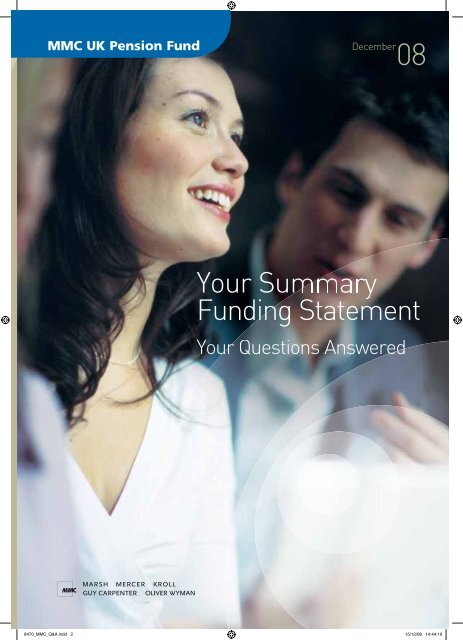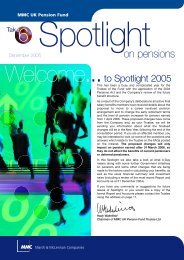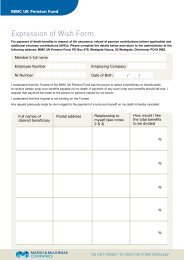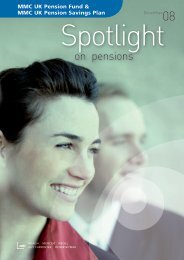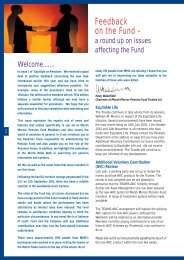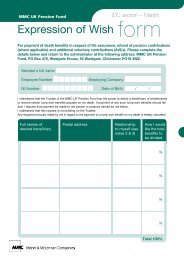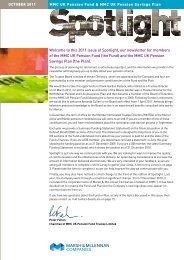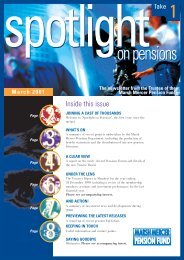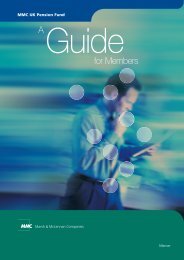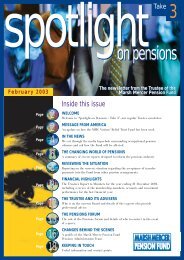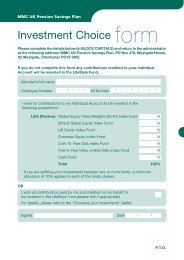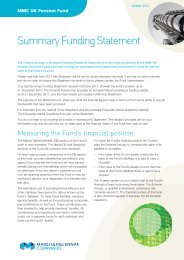FAQs - MMC UK Pensions
FAQs - MMC UK Pensions
FAQs - MMC UK Pensions
- No tags were found...
Create successful ePaper yourself
Turn your PDF publications into a flip-book with our unique Google optimized e-Paper software.
<strong>MMC</strong> <strong>UK</strong> Pension FundDecember08Your SummaryFunding StatementYour Questions Answered8470_<strong>MMC</strong>_Q&A.indd 2 15/12/08 14:44:19
<strong>MMC</strong> <strong>UK</strong> Pension FundThe attached Summary Funding Statement is an important document. You should read theStatement to help you understand the Fund’s current financial position and how it might affectyour retirement benefits in different circumstances.123Why have I received this Statement?Since 2006, it has been compulsory for trustees ofdefined benefit pension schemes like ours to sendall members a Summary Funding Statement eachyear. Before that, the Trustee routinely providedmost of this information in special editions of‘Spotlight on pensions’.The Statement shows that my fund has ashortfall. Is this the Trustee’s fault?The Statement is based on the latest actuarialvaluation which provides a snapshot of the Fund’sfinancial position at a particular date. Providingpensions is a long term business and at any timethere may be more or less money in the Fundthan is required to provide benefits now and inthe future.The Trustee regularly monitors the situation andis responsible for talking to the participatingcompanies about the level of contributions to bepaid to the Fund in the future.How has the shortfall happened?The cost of providing pension benefits hasincreased significantly in recent years, as averagelife expectancy has increased. At the same timethe investment returns that pension schemes haveachieved have dropped significantly.A shortfall has therefore arisen between theamount of money the Fund holds and the cost ofproviding the promised benefits. The contributionspaid to the Fund by the participating companiesare set at a level intended to remedy this situation.5In the same way, if the participating companieswere to be put into liquidation and the Fund didnot have enough assets to buy all the promisedbenefits, the Trustee would apply to the PPF forhelp in providing members’ benefits.If a scheme enters the PPF, the assets of thatscheme will be applied by the PPF to providebenefits for members according to a publishedscale, details of which can be found on the PPF’swebsite at www.pensionprotectionfund.org.uk.Does the current shortfall mean I won’t getmy full pension?No it does not. However, if the Fund wasdiscontinued or wound up with insufficient assetsto meet the cost of providing all members withbenefits and the participating companies wereunable to bridge the gap in the Fund’s finances,the Trustee may make an application to thePPF. If the Fund was able to enter the PPF,members who had not reached the Fund’s NormalRetirement Age would receive benefits in line withthe compensation provided by the PPF, which maybe less than the benefits they are entitled to fromthe Fund.Pensioners of the Fund who have reached theFund’s Normal Retirement Age would still receive100% of their pension entitlement. However,pensions in payment would only be increasedannually by the lower of 2.5% and the changein the Retail Prices Index in respect of servicecompleted on and after 6 April 1997. Pensionearned in respect of service completed before6 April 1997 would not be increased.4What happens if the participating companiesget taken over/go out of business?If the participating companies were taken over,the new company would take responsibility for theFund or offer another pension arrangement in itsplace. If the Fund is wound up, the participatingcompanies are responsible for making goodany shortfall. In the event that the shortfall is notremoved, the Trustee of the Fund could applyto the Pension Protection Fund (PPF) for help inproviding members’ benefits.6Were any benefit changes made as part of thevaluation process?Following the 31 December 2006 valuation noFund benefits have been modified to enable theTrustee and Employer to reach agreement onthe funding nor has there been any direction fromthe <strong>Pensions</strong> Regulator.The PPF acts as a safety net for those employeeswho have benefits in a pension scheme, wherethe main or only employer can no longer afford toprovide those benefits.328470_<strong>MMC</strong>_Q&A.indd 3 15/12/08 14:44:19
789Do I need to do anything because ofthis Statement?No. The Government’s intention behind introducingthese statements for members is to provide everyonewith more information about how the financingof their pension scheme works. The aim is togive members a better understanding of the risksinvolved in pension schemes, so you can makeinformed decisions about how you plan for yourfinancial future.Should I stay in the Fund?You have the right to opt out of the Fund for futureservice. However, before taking this decision youshould seek independent financial advice.Saving for your retirement is a long-term process.The value of your defined benefit pension is oftenone of the most valuable assets that you will buildup during your life. Any decision to leave the Fundshould not be taken lightly or influenced by isolatedpieces of information.You should note that if you decide to leave the Fundyou may not be able to rejoin the Fund at a laterdate. In the case of Marsh employees if you areallowed to rejoin the Fund after leaving you will onlybe able to join the Defined Contribution section.Are there other ways I can save?There are other ways in which you can save for apension. Whether you regard these as better or saferwill depend on your own feelings about the level ofrisk with which you are comfortable.You can pay into more than one pension scheme atthe same time and still receive tax relief (there arelimits on the tax relief you can receive, but they areset very high so they affect only a very few people).Before using another vehicle to save for yourpension, it is important that you take advice from anindependent financial adviser (IFA). An IFA will takeaccount of your circumstances before recommendingone (or more) methods.To find an IFA in your local area visit the IFAPromotion Ltd website: www.unbiased.co.uk.10111213How do I know which Section I’m in?The Fund is split into three Sections – Marsh,Sedgwick and Mercer. Broadly, members areallocated to the Sections as follows:• The Sedgwick Section covers former members ofthe Sedgwick Group Pension Scheme. The Brokingsub-section relates to those members nowemployed by Marsh Services and Insolutionsand the Consulting sub-section relates to thosemembers now employed by Mercer.• The Marsh Section covers all members(other than Sedgwick Broking sub-sectionmembers) employed by Marsh Services, includingGuy Carpenter, or a sister company (if youare an active member of the Fund the currentsister companies are Marsh (Isle of Man); MarshManagement Services Isle of Man and Insolutions).• The Mercer Section covers all members (otherthan Sedgwick Consulting sub-section members)employed by Mercer or a sister company (if youare an active member the current sister companiesare Oliver Wyman Consulting; Oliver Wyman; Delta;NERA; Victor O. Schinnerer and Ellis HaywardGroup). Members formerly employed by Putnamare also in the Mercer Section.Under the Trustee’s recovery plan, why isless being paid into the Sedgwick Consultingsub-section than the Sedgwick Broking subsectionwhen the Sedgwick Broking sub-sectionis better funded?The amount being paid to the Sedgwick Consultingsub-section is lower than the amount being paid tothe Sedgwick Broking sub-section because thereare fewer members in the former sub-section andthe overall liabilities are lower (£423m compared to£1,493m as at 31 December 2007).Has there been a payment to the participatingcompanies out of Fund monies in the last12 months?No. There has not been a payment to any of theparticipating companies out of Fund monies in thelast 12 months.How is the Fund invested?The Trustee invests contributions in a broad range ofassets. The weighting of assets in each Section varies.However, overall, the target weighting is for 42% ofthe assets to be held in fixed interest securities and58% of the assets to be held in equities.438470_<strong>MMC</strong>_Q&A.indd 4 15/12/08 14:44:27


